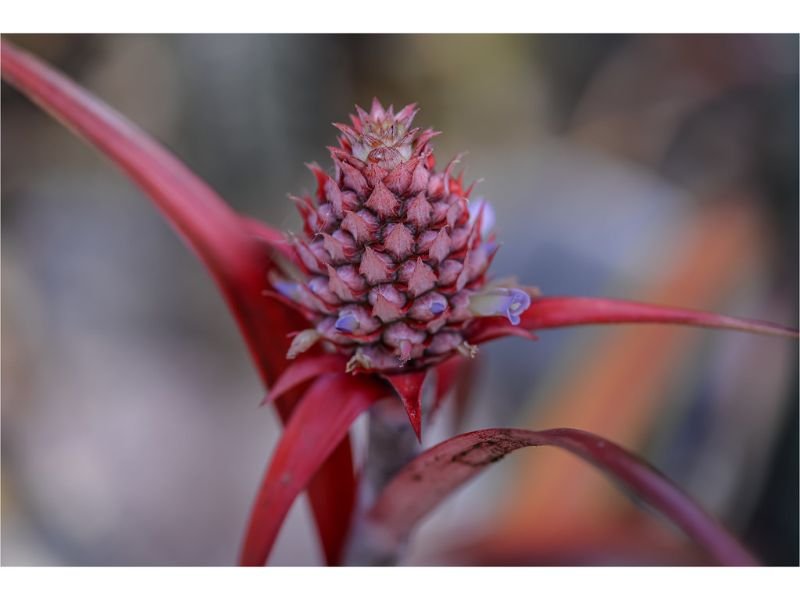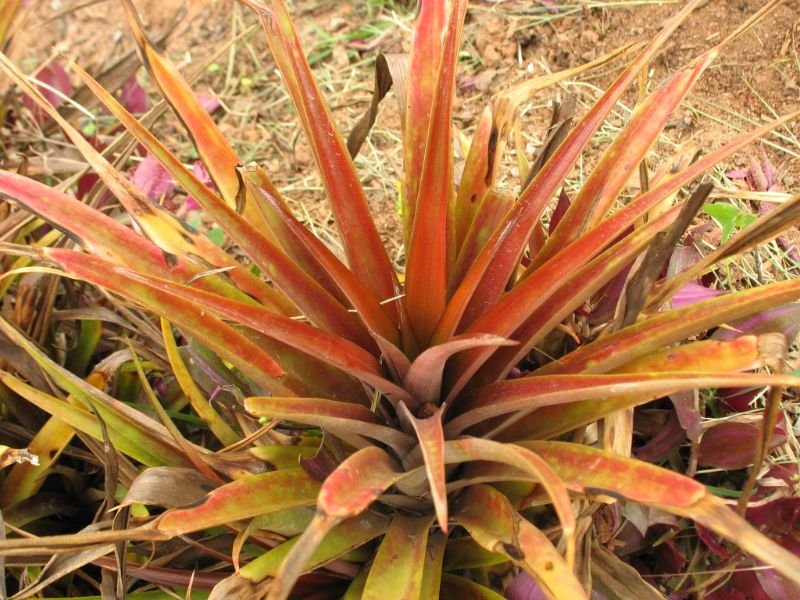Have you ever heard of the Ananas Lucidus or Red Spineless Pineapple plant? If not, get ready to learn about one of the most unique and fascinating plants out there! The Ananas Lucidus is a type of pineapple plant that is native to South America.

What makes this plant so special compared to other pineapple plants is that it produces a fruit that has a distinct taste and appearance. The fruit of an Ananas Lucidus plant is smaller than a typical pineapple and has a bright reddish-orange color when ripe.
The flesh inside the fruit is white with a yellow hue and has a sweet, tangy flavor with hints of citrus. This makes it an excellent addition to any tropical drink or dish requiring some extra flavor.
But the unique features don’t stop with the fruit itself – the Ananas Lucidus plant also looks different from other pineapple plants. For one, its leaves are more slender and pointed than those of other pineapples, giving it an elegant look.
It also has fewer spines on its leaves, which makes it less dangerous for those who may be handling or caring for it. Now that you have an idea of what makes the Ananas Lucidus plant so special, let’s dive into some more details about its features and how to care for it!
Table of Contents
What is Ananas Lucidus plant/ Red Spineless Pineapple?
Ananas Lucidus, also known as the shining pineapple or “Piña de Oro” in Spanish, is a tropical fruit plant that belongs to the Bromeliad family. It is native to South America and has been cultivated for centuries due to its delicious fruit and ornamental value. Unlike the common pineapple, Ananas Lucidus has a smaller size, with fruits weighing up to 1 lb. The fruit itself is juicy and sweet with a mild tangy flavor that makes it perfect for cocktails, smoothies, or desserts.
Physical appearance and characteristics of the plant
The Ananas Lucidus plant grows in a rosette pattern composed of long thin leaves with sharp edges that can grow up to 3 feet long. The leaves are green at the base but turn into a bright shade of red once they mature. The center of the rosette holds the flower stalk from which small purple flowers bloom before giving way to a small pineapple-looking fruit.
One notable feature of this plant is its shiny appearance which gives it its name “shining pineapple”. Its texture is smooth almost like polished glass making it quite attractive as an ornamental houseplant.
Comparison to other pineapple plants
As mentioned earlier, Red Spineless Pineapple differs from other varieties of pineapple plants in terms of size and appearance. While common pineapples can weigh up to 10 lbs and have spiky leaves, Ananas Lucidus fruits are smaller in size and their leaves are thin without spikes.
Another difference between Ananas Lucidus and other types of pineapple plants is their growth habit. Unlike regular pineapples that grow upright on one single stalk, Ananas Lucidus produces multiple suckers around its base creating an attractive clump-like shape that makes it ideal for landscaping purposes or as an indoor ornamental plant.
Further reading:
- The Best Indoor Plant Grow Lights for Thriving Houseplants
- Gardening Books: Essential Reads for Green Thumbs
- DIY Garden Projects: Creative Planting Ideas
- The Ultimate Guide to Organic Fertilizers for Healthy Plant Growth
- Must-Have Garden Insecticide for Pest Control Solutions
The Beauty and Health Benefits of Ananas Lucidus Plant
Ananas Lucidus, also known as the wild pineapple, is not just a pretty and exotic fruit that can add diversity to your diet. It also offers numerous health benefits that make it a worthwhile addition to your garden or home. One of the most significant health benefits of Ananas Lucidus is its high content of bromelain.
This enzyme has anti-inflammatory properties and can help improve digestion, reduce inflammation, and promote healthy skin. Moreover, Ananas Lucidus is an excellent source of vitamin C. Just one cup of chopped fruit can provide more than 100% of your daily recommended dose.
Vitamin C is essential for boosting your immune system, preventing chronic diseases like cancer and heart disease. Aside from the nutritional value that comes with consuming the fruit itself, having an Ananas Lucidus plant in your home or garden can also bring aesthetic value.
Its unique shape, spiky leaves, and bright yellow-green color make it a striking addition to any space. Plus, if you are looking for an indoor plant that requires minimal attention but still looks stunning all year round, then Ananas Lucidus should be at the top of your list.
With proper care instruction (which we will cover later), this specimen can thrive indoors without needing too much water or sunlight. Overall, owning an Ananas Lucidus plant comes with both health benefits and visual appeal – two great reasons to add this fascinating plant to your collection!
How to care for an Ananas Lucidus plant

Soil requirements and ideal growing conditions
In order for an Ananas Lucidus plant to thrive, it needs well-draining soil with a pH range of 4.5 to 6.5. The soil should be rich in organic matter, such as compost or peat moss, and should be loose enough to allow for proper root growth. These plants also prefer warm temperatures between 68-86°F (20-30°C), so it’s best to keep them in a bright and sunny spot indoors or in a warm outdoor location.
Watering frequency and methods
Ananas Lucidus plants require moderate watering, but overwatering can lead to root rot and other issues. It’s important to keep the soil moist but not waterlogged, so you should water the plant once or twice per week depending on how dry the soil feels. Don’t forget that these plants are sensitive to chlorine and fluoride that may be present in tap water, so it’s best to use filtered or distilled water if possible.
Fertilization schedule and type of fertilizer to use
To encourage healthy growth and fruit production, Ananas Lucidus or
To encourage healthy growth and fruit production, Ananas Lucidus or Red Spineless Pineapple plants need regular fertilization during their growing season from spring through summer. You can use a balanced fertilizer with equal parts nitrogen, phosphorus, and potassium every two weeks during this time frame.
plants need regular fertilization during their growing season from spring through summer. You can use a balanced fertilizer with equal parts nitrogen, phosphorus, and potassium every two weeks during this time frame.
Alternatively, you can use organic fertilizers like compost tea or fish emulsion which will provide the necessary nutrients without harming the plant or surrounding environment.
Common Problems with Ananas Lucidus Plants
Pests and Diseases that Can Affect the Health of the Plant
One of the most common pests that can affect Ananas Lucidus plants is mealybugs. These small insects feed on the plant’s sap and can cause stunted growth, yellowing leaves, and even death if left untreated. Another common pest is spider mites, which are tiny arachnids that can spin webs around the plant and cause leaves to curl up and turn brown.
Diseases that can affect Ananas Lucidus plants include root rot, which is caused by overwatering and poor drainage, as well as leaf spot disease, which causes brown spots on the plant’s leaves. It is important to catch these issues early on to prevent further damage.
How to Identify and Treat These Issues
If you suspect your Ananas Lucidus plant has a pest or disease issue, it is important to act quickly. To identify mealybugs or spider mites, look for white cottony growths or webs on the plant’s leaves or stem.
For root rot or leaf spot disease, look for brown spots on the leaves or signs of wilting. To treat these issues, it may be necessary to use an insecticide or fungicide specifically designed for pineapple plants.
For mealybugs and spider mites, you can also try removing them manually using a cotton swab dipped in rubbing alcohol. In addition to treating pests and diseases directly, it is important to ensure your Ananas Lucidus plant is getting proper care in terms of watering frequency and soil quality to prevent future issues from arising.
Harvesting and consuming Ananas Lucidus fruit

When to harvest the fruit for optimal flavor and ripeness
When it comes to harvesting Ananas Lucidus fruit, timing is everything. The fruit is ready for consumption when it reaches its peak ripeness, which typically occurs between 6 and 8 months after planting.
A fully ripe Red Spineless Pineapple will have a yellowish-orange color with a sweet aroma. To check if the fruit is ripe, give it a light tug.
If it comes off easily from the center stalk, then it’s ready to be harvested. However, don’t wait too long as overripe fruits tend to lose their sweetness and become less desirable.
Different ways to prepare and consume the fruit
Ananas Lucidus can be enjoyed in many different ways once harvested. One popular method of consumption is eating the juicy flesh raw or as juice after removing its spiky skin and tough core.
Another way of consuming Ananas Lucidus is by making desserts such as pineapple ice cream or sorbet. The fruit’s naturally sweet flavor makes an excellent addition to smoothies or cocktails as well.
If you’re feeling adventurous, why not try grilling slices of your harvested Ananas Lucidus for a unique twist on traditional BBQ dishes? Or even using them in savory recipes like salads or stir-fries for added texture and flavor.
Harvesting and consuming an Ananas Lucidus plant’s fruits require patience but are well worth the wait. There are several ways to enjoy this sweet tropical delicacy that’s packed with nutrients beneficial for health!
Conclusion
Caring for an Ananas Lucidus plant requires specific attention to detail, but the rewards are well worth it. Remember to provide proper soil and water conditions, as well as regular fertilization, to ensure a healthy and thriving plant.
While there are some challenges to maintaining the health of your plant, such as pests and diseases, knowing how to identify and treat these issues can prevent them from becoming a major problem. One of the greatest benefits of owning an Ananas Lucidus plant is the delicious fruit it produces.
The fruit offers numerous health benefits and can be consumed in a variety of ways. Whether you prefer it fresh or cooked, there is no denying the satisfaction that comes with harvesting your own fruit.
In addition to its practical value, Ananas Lucidus plants can also serve as beautiful ornamental plants in both indoor and outdoor settings. The unique appearance of the leaves and fruit make for an interesting addition to any garden or living space.
Overall, owning an Ananas Lucidus plant can be a rewarding experience for those who are willing to invest time and effort into its care. With proper attention paid to its needs, your Ananas Lucidus plant will thrive for years to come!

Gardening is my passion and growing plants indoors has always been a stress relief for me. Grow a banana tree in my apartment once (although failed to produce bananas).






